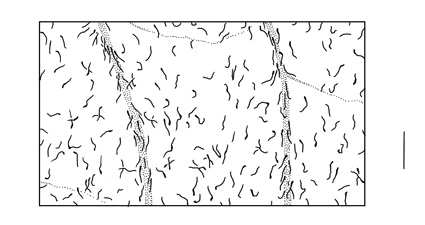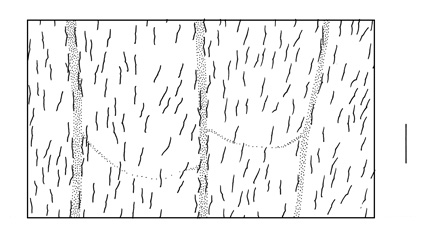Cornus sanguinea L. (syn.: Swida sanguinea (L.) Opiz, Thelycrania sanguinea (L.) Fourr.) (Eur.) – A locally common native species, most often seen in wood- and scrubland on limestone or clay. Furthermore much cultivated for ornament and frequently birdsown in places where Cornus sanguinea probably is not native.
Plants in cultivation are quite variable and obviously belong to several taxa. These are often given specific rank (see for instance Holub 1997, Wann 1997). The extremes are indeed rather characteristic but intermediates are frequent and hence subspecific rank is probably more appropriate. Those currently found in Belgium are distinguished in the following couplet:
- Lower leaf surface with an indumentum of appressed, medifixed hairs only === subsp. australis
- Lower leaf surface with an indumentum of predominantly single, patent, often curved hairs, occasionally intermixed with some medifixed hairs (native) === subsp. sanguinea
Cornus sanguinea subsp. australis (C.A. Mey.) Jáv. ex Soó in Soó et Jáv. (syn.: C. sanguinea var. australis (C.A. Mey.) Koehne, C. australis C.A. Mey., Swida sanguinea (L.) Opiz subsp. australis (C.A. Mey.) Kubát, S. australis (C.A. Mey.) Pojark. in Grossheim, Thelycrania australis (C.A. Mey.) Sanadze) is a native of SW-Asia and SE-Europe. It is poorly known in Belgium but possibly rather widespread as an escape from or relic of cultivation (often birdsown). Recorded since 2008 as an escape in riparian habitats (along rivers Leie and Schelde) (Verloove 2011) and doubtlessly widely overlooked elsewhere. Since 2010 furthermore seen in a wide range of man-made and more or less natural habitats (off ramps, coalmine heaps, ...). Also regularly seen in sand raised sites (for instance in Brugge and Lanaken) and in coastal dunes. This taxon (and possibly also its hybrid with the native race - see below) might in fact have become more widespread than subsp. sanguinea. In some of its localities, subsp. australis is obviously naturalised by now.
Some populations represent the hybrid of subsp. australis and subsp. sanguinea. Such plants exhibit the typical appressed indumentum of medifixed hairs of subsp. australis, intermixed with simple, curved hairs (especially on the veins) and are usually referred to as Cornus (x)hungarica Kárpáti (syn.: C. sanguinea subsp. hungarica (Kárpáti) Grosset, Swida hungarica (Kárpáti) Soják). This nothotaxon is present, for instance, on sunexposed talus slopes of the canal Kortrijk-Bossuit in Moen (observ. 2010).
Cornus sanguinea – especially large-leaved (cultivated) forms – is sometimes surprisingly similar to C. sericea. In the absence of flowers or fruits both are sometimes very reminiscent. The number of lateral veins often overlap in both species. However, in Cornus sanguinea leaves are greenish beneath (only slightly paler than above), whereas in C. sericea they are obviously paler beneath than above. Moreover, leaves are typically abruptly acute in Cornus sanguinea and rather long-acuminate in C. sericea.


Cornus sanguinea subsp. sanguinea

Cornus sanguinea subsp. australis
|
|
|
Selected literature
Holub J. (1982) Poznámky k slovenským zástupcum rádu Cornales, 2. Zprávy Ceskoslov. Bot. Spolecn. Ceskoslov. Akad. Ved. 17: 1-24.
Holub J. (1997) Cornaceae. In: Slavík B. (ed.), Kvetena Ceské Republiky, vol. 5. Academia, Praha: 252-265.
Ludwig W. (1999) Cornus sanguinea (aff.) subsp. australis, angepflanzt und verwildernd: ein Nachtrag zu Ludwig et Lenski (1971). Hess. Flor. Briefe 48(3): 54-56.
Ludwig W. & Lenski I. (1971) Cornus (Swida) x hungarica in Rheinhessen und an der Bergstrasse. Hess. Flor. Briefe 20: 9-12.
Sanders C. (2005) Shedding light on Cornus sanguinea. The New Plantsman 4(4): 198-203.
Sell P. (2007) Introduced ‘look-alikes’ and other difficult introduced plants in our Cambridgeshire flora. BSBI News 105: 24-30.
Soják J. (1962) Swida hungarica (Kárp.) in der Tschechoslowakei. Acta Dendrol. Cechoslov.3/1961: 105-107.
Soják J. (1967) Swida australis na Morave. Zprávy Ceskoslov. Bot. Spolecn. Ceskoslov. Akad. Ved. 2: 100-102.
Stohr O. (2001) Ein Fund von Cornus sanguinea L. ssp. hungarica (Karpati) Soó aus dem Landkreis Berchtesgadener Land. Ber. Bayer. Bot. Ges. 71: 39-40.
Verloove F. (2011) Fraxinus pennsylvanica, Pterocarya fraxinifolia en andere opmerkelijke uitheemse rivierbegeleiders in België en NW-Frankrijk. Dumortiera (in press).
Wann J.D. (1997) Cornus. In: Cullen J. & al. (eds.), The European Garden Flora, vol. 5. Cambridge University Press, Cambridge: 362-366.


